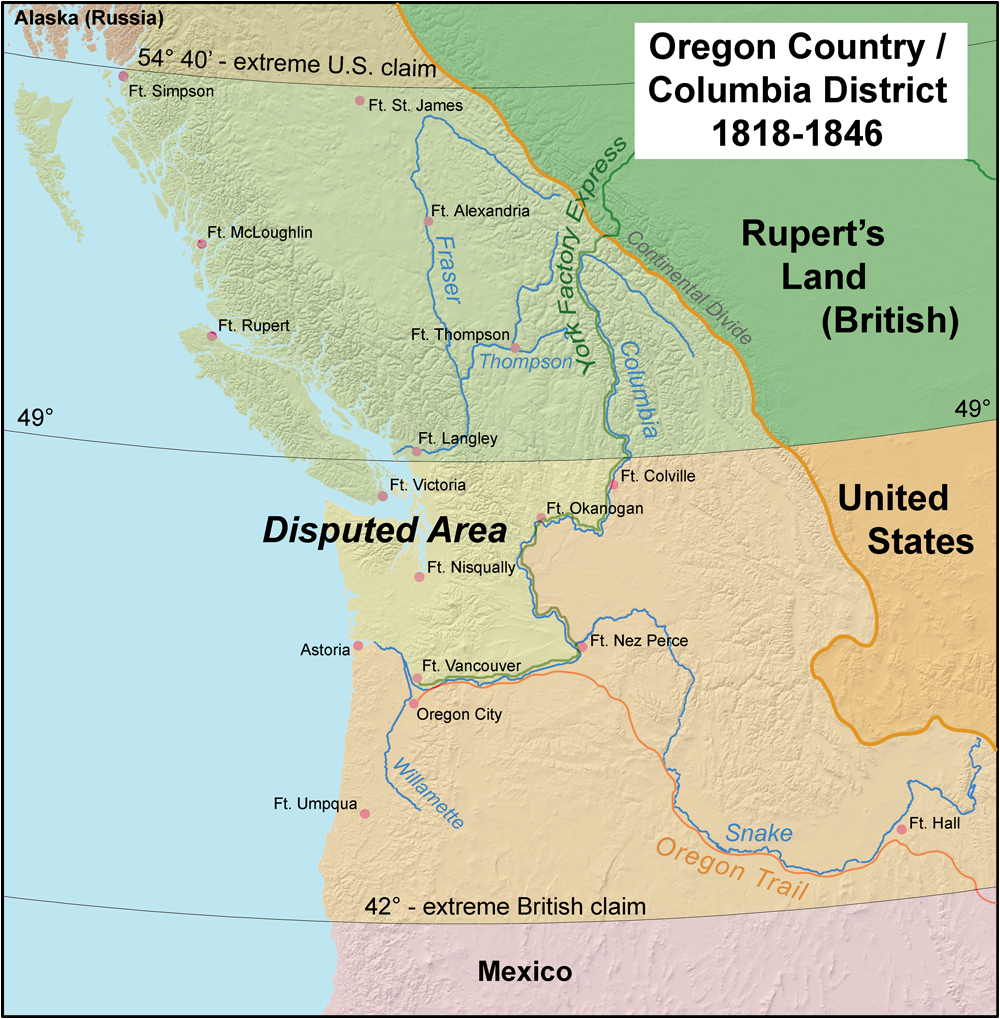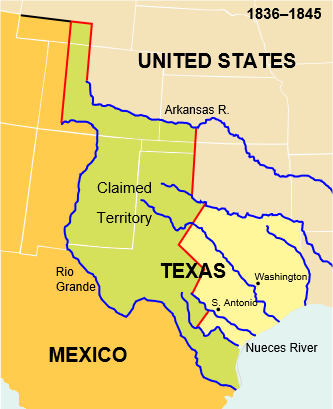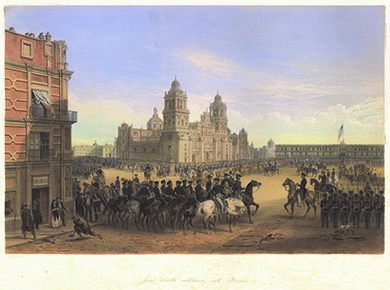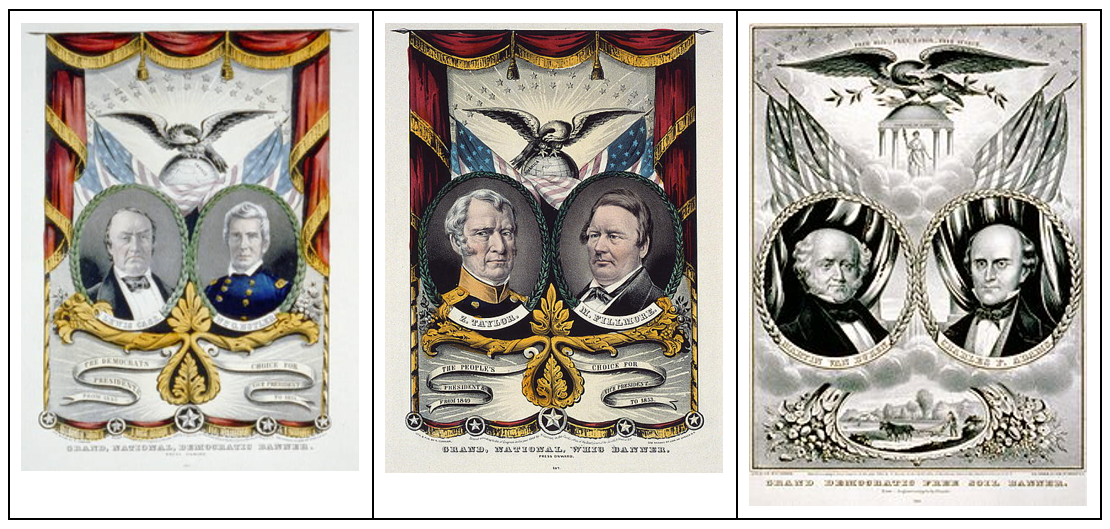Table of Contents |
Alongside John L. O’Sullivan, support of Manifest Destiny was best personified by James K. Polk, who was elected president of the United States in 1844.
A devoted supporter of Andrew Jackson, Polk was a former congressman and governor from Tennessee who won the nomination of the Democratic Party in 1844. He was also a slaveholder who owned cotton plantations in Tennessee and Mississippi.
In addition to his political and economic background, Polk gained the nomination and, ultimately, the presidency by being an unequivocal champion for westward expansion. He endorsed the annexation of Texas, giving little thought toward its potential impact on sectional tensions. He also argued that the United States should gain title to the entire Oregon territory from Great Britain. American control of the territory was to stretch to its northern boundary with Alaska at the latitude 54°40'.
If American expansion had truly been a Manifest Destiny, it would have occurred peacefully. Yet expansion required deliberate planning and constant government action. Politics, diplomacy, and conflict were as much a part of Manifest Destiny as covered wagons on western trails, and President Polk displayed skills in all three areas.
After taking office in the spring of 1845, Polk focused much of his initial attention on resolving the Oregon question, or the joint-occupation of Oregon Territory by the United States and Great Britain. As permanent American settlement in the region tipped the balance of power in Oregon in favor of the United States, both powers recognized the need to revisit the original joint-occupation agreement.

Great Britain proposed that the pre-existing boundary between the United States and Canada along the 49th parallel simply be expanded westward to the Columbia River, at which point the border would continue along the Columbia to the Pacific Ocean. Meanwhile, the United States argued for the westward extension of the boundary along the 49th parallel to the Pacific Ocean.
After several months of debate and deliberation, Great Britain and the United States reached a compromise during the late spring and early summer of 1846. Both sides agreed to extend the boundary between Canada and the United States westward along the 49th parallel with the exception of Vancouver Island, which remained in British hands. In exchange for relinquishing its claims to the southern tip of Vancouver Island, the United States received control of the entire "disputed triangle."
With the Oregon Question resolved, Polk focused his entire attention on Texas and Mexico.
Conflict between the United States and Mexico revolved around Texas, which the United States formally annexed in 1845, shortly before Polk took office. Mexico interpreted the annexation as “an act of aggression” and severed diplomatic relations.
Tensions between the United States and Mexico centered largely on this question: what constituted Texas? At the end of the Texas War for Independence, Santa Anna was pressured to recognize the Rio Grande as the border between Texas and Mexico. The United States supported Texas’s claim. Mexico, however, refused to be bound by Santa Anna’s promises and insisted the border lay farther north, at the Nueces River.

Upon annexation, Polk wasted no time in sending American troops to the disputed territory between the Rio Grande and Nueces River. He instructed a U.S. force to construct a fort on the north side of the Rio Grande, which, from the Mexican perspective, appeared to be a violation of their sovereign territory.
On April 24, 1846, American soldiers were attacked by a Mexican cavalry unit on patrol near the town of Matamoros, a town situated on the southern banks of the Rio Grande. In response, Polk sent more troops under General Zachary Taylor to the disputed territory between the Nueces and Rio Grande. U.S. naval squadrons also anchored near Veracruz and Mazatlan, prepared to blockade Mexico’s chief ports if war broke out.
After a failed attempt to negotiate with Mexico (one in which the United States continued to insist on the Rio Grande as the border), Polk asked Congress to declare war on Mexico on May 9, 1846. At one point, he angrily declared that Mexico “had passed the boundary of the United States (the Rio Grande), has invaded our territory and shed American blood upon the American soil…."
Despite opposition from Lincoln and other antislavery Whigs, Congress formally declared war on Mexico on May 12, and the Mexican-American War began.
U.S. military strategy during the Mexican-American War had three main objectives:
1. Take control of northern Mexico, including present-day New Mexico
General Zachary Taylor accomplished much of this first goal. In the fall of 1846, he captured the city of Monterrey in northern Mexico. He then turned back Santa Anna’s army at the Battle of Buena Vista in February 1847.
Meanwhile, an Army of the West under General Stephen Watts Kearny marched westward from Fort Leavenworth (in present-day eastern Kansas) to New Mexico. On August 18, 1846, his forces entered Santa Fe without firing a shot. Before departing for California, Kearny organized a new civil government for New Mexico and appointed Charles Bent, the owner of Bent’s Fort in present-day southeastern Colorado, to lead it.
2. Seize California
General Kearny would arrive in California to find it already in American hands through the joint efforts of California settlers, U.S. naval commander John D. Sloat, and John C. Fremont, a former army captain and son-in-law of Missouri senator Thomas Benton. Sloan had been at anchor off the coast of Mazatlan when he learned that the United States had declared war on Mexico. He then quickly set sail for California. He seized the town of Monterey in July 1846, less than a month after a group of American settlers led by William B. Ide had taken control of Sonoma and declared California a republic. A week after the fall of Monterey, the U.S. navy took San Francisco with no resistance.
3. Capture Mexico City
General Winfield Scott accomplished this objective and his army faced the stiffest resistance of the war. Scott captured Veracruz in March 1847, and moving in a northwesterly direction from there (much as Spanish conquistador Hernán Cortés had done in 1519), he slowly closed in on the capital. Every step of the way was a hard-fought victory, however, and Mexican soldiers and civilians both fought bravely against the American invaders. During the siege of Mexico City, a number of defenders, including young military cadets, fought to the end.

On September 14, 1847, Scott entered Mexico City’s central plaza and the war was essentially over. Subsequent negotiations culminated in the Treaty of Guadalupe Hidalgo, which was signed in February 1848. Its terms included:

Throughout the war, northern Whig politicians criticized Polk's conduct, and concluded that the president sought territory from Mexico in order to provide for the expansion of slavery.
In August 1846, Polk requested a $2 million appropriation from Congress to defray any potential costs of a peace negotiation between the United States and Mexico. Upon hearing of the request, David Wilmot, a Democrat from Pennsylvania, introduced an amendment that agreed to the appropriation on one condition: that slavery would not be permitted in any western territory acquired during the war. This amendment came to be known as the Wilmot Proviso.
That Wilmot, a loyal Democrat, attempted to counter the actions of Polk, a Democratic president, hinted at the party divisions that were to come. That the Wilmot Proviso passed the House of Representatives along sectional lines foreshadowed the growing division between North and South.
EXAMPLE
Northern representatives voted for the proviso regardless of their party affiliation. Southern representatives voted overwhelmingly against the proviso.The Senate went on to kill the appropriation (including the Wilmot Proviso) during a filibuster, and Polk would eventually receive the money necessary to conduct treaty negotiations with Mexico. But the significance of the failed Wilmot Proviso lay in the fact that the vote fell according to sectional differences over slavery.
In an attempt to resolve any tension regarding the issue of slavery in western territories that the failed Wilmot Proviso exposed, members of the Democratic Party introduced a new position: popular sovereignty.
Lewis Cass, a Democrat from Michigan, was among the first political officials to advocate for this idea, but there were many others within the Democratic Party who supported the notion. According to the promoters of popular sovereignty, slavery was a matter for the individual territories and states to decide. Residents of a territory could vote on whether to allow slavery and Congress should not interfere with this process.
Meanwhile, some northern politicians (predominantly antislavery Whigs but also some Democrats who had become frustrated with the political influence of southern slaveholders) adopted the exact opposite position. They were willing to let slavery remain in the South, but they were increasingly unwilling to provide for the expansion of the institution into western territories. These politicians started to articulate the notion of free soil.
The advocates of free soil were not motivated by racial equality or humanitarian concerns. Rather, they employed rhetoric associated with free labor ideology.
EXAMPLE
David Wilmot publicly referred to the Wilmot Proviso as a "White Man's Proviso," by arguing that it sought to protect free White laborers from any unfair competition that might accompany the expansion of racial slavery into the territories acquired from Mexico.The political divide over slavery—between North and South, between the doctrines of popular sovereignty and free soil—erupted during the presidential election of 1848.
Three political parties and presidential candidates emerged. The table below represents the characteristics and circumstances of each party and includes the campaign poster for each.
| Lewis Cass | Zachary Taylor | Martin Van Buren |
|---|---|---|
|
Nominated by Democrats (since Polk already promised to serve only one term as president)
Known as the champion of popular sovereignty |
Nominated by Whigs
Known as the military hero of the Mexican-American War Slaveholder from Louisiana |
Nominated by the Free-Soil Party composed of antislavery Whigs and northern Democrats in a frustrated response to Cass and Taylor’s nominations
|

| ||
The Free-Soil Party, which was comprised exclusively of northern politicians, had one goal: to oppose the expansion of slavery into the West. In the minds of its members, southern slaveholders had marshaled their wealth and power to control national politics for the purpose of protecting slavery and extending it into the territories. Many in the Free Soil Party even believed that a slaveholding elite conspired to control domestic and international affairs through a cabal that came to be known as Slave Power.
The Free-Soil Party did not gain many votes and Zachary Taylor ultimately won the election of 1848. But it was clear that western expansion had allowed slavery to enter national politics once again.
Source: This tutorial curated and/or authored by Matthew Pearce, Ph.D with content adapted from Openstax “U.S. History”. access for free at openstax.org/details/books/us-history LICENSE: CREATIVE COMMONS ATTRIBUTION 4.0 INTERNATIONAL